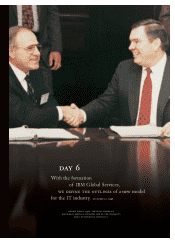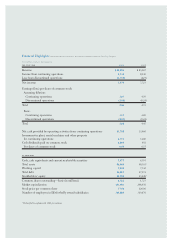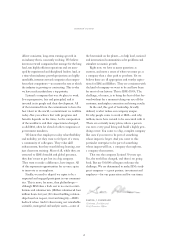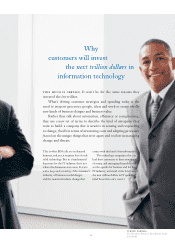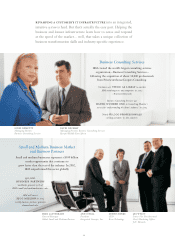IBM 2002 Annual Report Download - page 19
Download and view the complete annual report
Please find page 19 of the 2002 IBM annual report below. You can navigate through the pages in the report by either clicking on the pages listed below, or by using the keyword search tool below to find specific information within the annual report.17
pioneering such services—server and storage capacity,
as well as business processes like procurement and
claims processing—for companies such as American
Express, The Dow Chemical Company and Mobil
Tr avel Guide. But we also want to equip and help
customers to build their own internal
utilities—
software to manage and balance workloads,
and
server and storage systems to provide additional
capacity on demand.
Clearly, the bet we’re placing on e-business on
demand is a big one. And part of what makes it big
is that it encompasses where both computing and
business are headed. Driving both at the same time
requires a lot of work, but it’s necessary, if you
aspire to lead this industry.
ibm’s center of gravity
Throughout IBM’s history, we have reinvented
ourselves over and over again. The most visible
manifestation of this has been how radically our
product line has changed over time—from clocks
and scales to tabulating machines, to mainframes,
to Selectric typewriters, to everything we do today.
How were we able to make those transitions
without having a jarring identity crisis? It’s because
we never defined ourselves as a clock and scale
company, or a mainframe company, or a typewriter
maker, even when we were the undisputed leader
in those markets. We simply committed ourselves
to being the leader in inventing state-of-the-art
technology and helping customers apply it to solve
their problems. When technology and the nature
of customer problems change—we do, too.
As I said earlier, the one time we forgot that
and held on too long to products and ideas that
were giving way to new ones, we nearly lost the
whole ball game. That’s a lesson we will not forget.
To day, with e-business on demand, we are
again redefining the value we bring to customers.
It’s driving us to grow certain businesses aggres-
sively—especially services and software—and to
de-emphasize others, as we did in 2002. I have no
doubt whatsoever that 15 or 20 years from now, we
will be in a bunch of new and different businesses,
because technology and customer problems will
have marched on, hopefully with our company at
the forefront. But we will still be IBM.
the purpose of a business
As you might guess by now, we have been doing
a lot of thinking about what leadership means for
IBM. To lead our industry, we must be the com-
pany to which our customers look to understand
the future of IT and how it can help them create
business value. But there are additional aspects of
leadership that are also important aspirations for
our company: as an investment, as an employer,
as a member of the community.
Now, companies often say that being a great
employer or a responsible citizen is as important
to them as creating shareholder value or delighting
customers or beating competitors. But they don’t
elevate them as business priorities, to be managed
with the same kind of investment and discipline—
and competitive passion—that they apply to
managing R&D, manufacturing and sales. We do.
Why? Because over time, failure to understand
change in these realms can be as damaging as failure
to stay abreast of markets or technology. Maybe
more so. What do investors value? What will attract
and motivate the best workforce in the world? What
do communities—nations and neighbors—expect
of companies? As with technology and customer
requirements, these are all moving targets.
We believe investors, particularly those who
invest in the technology sector, reward companies
that adapt, that continually create and lead the
high-value spaces—because that’s the only way to
chairman’s letter


